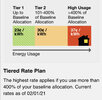Keeping in mind that I haven't been able to take long
trip due to some kind of pandemic, I decided to figure out what
was the fuel cost of driving the Tesla after my first 10 months.
My lifetime average due to mostly slow (35 to 50 mph roads) in NH is 239 wh/mi. Reaching the forums,
most highway commutes seem to be in the 280-300 wh/mi range.
It could be lower/better if I didn't launch myself but what fun would that be?
I only supercharged a few times in the first 10 months.
The first time was just a test (to prove everything was set up and I could supercharge)
8 kWh @ $0.28 = $2.24
In July, heading up to Mt Washington auto road, I put
20 kWh @ $0.26 = $5.20
and in September, I had 2 supercharging events
10 kWh @ $0.25 (to make sure I made it home, it was
really close and I was going by a supercharger so why chance it) = $2.50
43 kWh @ 0.26 (we decided last minute to go leaf peeping and I hadn't charged up the car the night
before) = $11.18
Total of 81 kWh.The car shows that I have added 1,358
kWh total for the 5,680 miles. Minus 81 means 1,277
kWh from home charging. Ignoring any solar aspect,
we'll use the standard rate of $0.15/kWh for home charging = $191.55
191.55 + 11.18 + 2.5 + 5.2 + 2.24 = 212.67
212.67 / 5680 = $0.037 per mile.
or 5680 / 212.67 = 26.7 miles per dollar.
With gas at $2.50/gallon, you would need to have a car
that provides 66.75 MPG to have the same economy.
At $2.75/gallon, you'd need 73.425 MPG
At $3/gallon, you'd need 80.1 MPG.
That is not factoring in other things such as oil
changes that a Tesla doesn't need. Assuming tire costs
and insurance is roughly the same for each car.
That's a bit lower than I expected. Solar, of course,
provides a lot more benefits but until I reach the ROI,
and break even (roughly 7.5 years), I just had to pay up
front instead of once in a while. After I reach ROI, the
charging is basically free.
trip due to some kind of pandemic, I decided to figure out what
was the fuel cost of driving the Tesla after my first 10 months.
My lifetime average due to mostly slow (35 to 50 mph roads) in NH is 239 wh/mi. Reaching the forums,
most highway commutes seem to be in the 280-300 wh/mi range.
It could be lower/better if I didn't launch myself but what fun would that be?
I only supercharged a few times in the first 10 months.
The first time was just a test (to prove everything was set up and I could supercharge)
8 kWh @ $0.28 = $2.24
In July, heading up to Mt Washington auto road, I put
20 kWh @ $0.26 = $5.20
and in September, I had 2 supercharging events
10 kWh @ $0.25 (to make sure I made it home, it was
really close and I was going by a supercharger so why chance it) = $2.50
43 kWh @ 0.26 (we decided last minute to go leaf peeping and I hadn't charged up the car the night
before) = $11.18
Total of 81 kWh.The car shows that I have added 1,358
kWh total for the 5,680 miles. Minus 81 means 1,277
kWh from home charging. Ignoring any solar aspect,
we'll use the standard rate of $0.15/kWh for home charging = $191.55
191.55 + 11.18 + 2.5 + 5.2 + 2.24 = 212.67
212.67 / 5680 = $0.037 per mile.
or 5680 / 212.67 = 26.7 miles per dollar.
With gas at $2.50/gallon, you would need to have a car
that provides 66.75 MPG to have the same economy.
At $2.75/gallon, you'd need 73.425 MPG
At $3/gallon, you'd need 80.1 MPG.
That is not factoring in other things such as oil
changes that a Tesla doesn't need. Assuming tire costs
and insurance is roughly the same for each car.
That's a bit lower than I expected. Solar, of course,
provides a lot more benefits but until I reach the ROI,
and break even (roughly 7.5 years), I just had to pay up
front instead of once in a while. After I reach ROI, the
charging is basically free.



